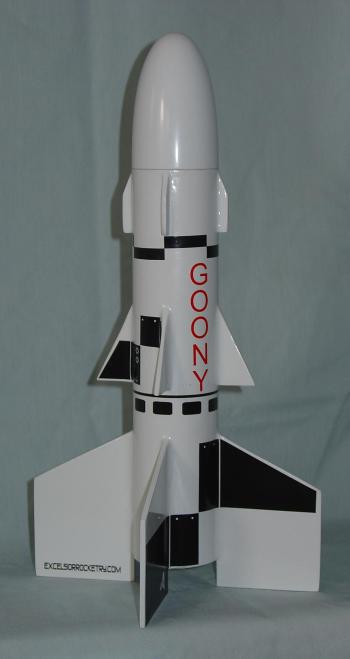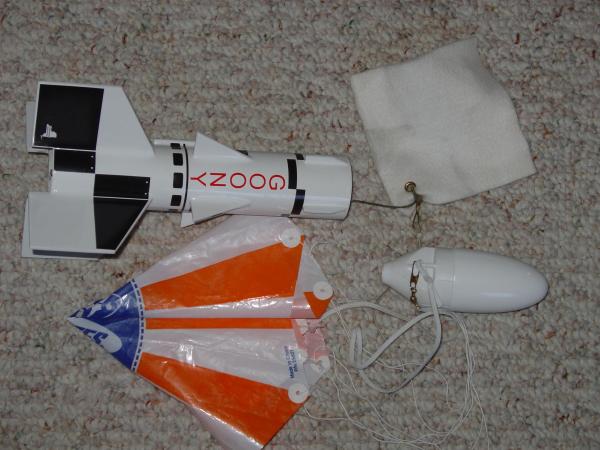Excelsior Rocketry Goonybird Nike-G (Plan)
Excelsior Rocketry - Goonybird Nike-G {Plan}
Contributed by Matthew Bond
| Construction Rating: | starstarstarstarstar_border |
| Flight Rating: | starstarstarstarstar |
| Overall Rating: | starstarstarstarstar |
| Manufacturer: | Excelsior Rocketry |

Brief:
The Nike-G is one of Excelsior Rocketry's “Goony Retro-Bash” line of
decal/plansets. Fred Talasco at Excelsior has created a line of kit-bashes that
are a throwback to the old Estes “Goonybirds”. All of Fred's designs
are based on old Estes kits, or original ideas, and use the Baby Bertha as the
starting point.
Construction:
My Nike-G plans, along with several other decals, arrived from Excelsior in a
sturdy priority mail envelope, with extra cardboard inserts to keep everything
well protected. Included in each “Goony” plan are the instructions
and fin templates, printed on a single sheet of cardstock with a nice color
picture of the finished rocket, and of course, the decal sheet, which is the
best part of the whole deal. The instructions and decals were packaged in a
sturdy plastic sheet protector, as are all the decals that Excelsior ships. The
builder must supply the other half of the project which consists of one Estes
Baby Bertha kit, and some balsa sheet stock for cutting out the new fins.
I originally went to Excelsior's website looking for some decals for a cloning project, and was immediately drawn to the “Goony Retro-Bash” heading. As I paged down through the collection of odd looking rockets with the familiar sounding names, I thought to myself, “what a great way to clean out all those Baby Bertha kits in the bottom of my project box”. A week later, I had several goony plans on my work table, but to my dismay, not a single Baby Bertha kit could I find. A week later I had that problem fixed, and since I was already working one a Nike-X clone, the Nike-G was the first Goony bird in line. The provided instructions are actually a list of “exceptions” and are meant to be used in conjunction with the regular Baby Bertha instructions. The Baby Bertha is a simple kit to build, made only a little more challenging by cutting and aligning multiple sets of fins. The motor mount is assembled first and I upgraded the recovery system (as I do with all my rockets) by adding a length of Kevlar® cord which is tied around the engine mount, threaded through the forward centering ring, and glued in place. The motor mount is installed in the body tube, and per the Nike-G notes, is pushed forward until the end of the engine hook is even with the end of the body tube. This puts the motor mount about ¾" father forward that normal and according to the notes, provides better stability. While the motor mount glue was drying I traced and cut out the 3 sets of fins/strakes, which take the place of the standard Baby Bertha fins. These were match sanded, and in keeping with the stout/blunt theme of the rocket, I left all the fin edges squared off. The stock Estes tube marking wrap is used to set the fin location, and I use a length of aluminum angle stock to mark the fin lines on my rockets. This is a great investment, the smaller sizes will fit on any mod roc tubing, and the resulting lines are perfectly straight. I read the directions for placement of the fins several times to make sure I had it clear, and a simple line drawing, while not required, would go a long way towards making this step really easy. My standard routine for attaching fins is to tack them on with wood glue (Titebond), add a second wood glue fillet, and then a final fillet of Elmers Wood Filler. Because of their small size, I did not add any fillets to the forward strakes. I attached the fins in sets, sighting along all three to get them aligned to each other. The launch lug is attached in the same fashion per the standard instructions. With the fun part over, it was time for finishing.
Finishing:
The paint scheme for the Nike-G is as simple as it gets, gloss white. The real
impressive look for this rocket comes from the decals. As with all of
Excelsior's products, the sharpness, and detail is awesome. There is a lot of
balsa to be prepped on this rocket, and all 12 fins/strakes were sealed with
SIG Sanding Sealer and sanded smooth with 400 grit sandpaper. Next came two
coats of primer (Rust-Oleum Painters Touch Sandable Primer), followed by two
coats of spray enamel (Krylon). The plastic nose cone is finished with the same
paint routine. When you get decals from Excelsior they come with a full page of
instructions for prepping, applying and finishing, and they recommend
Microscale brand products (Decal-Set and Micro-Sol) for accomplishing the job.
I wasn't particularly in the mood to add another line of noxious chemicals to
my hobby stockpile, so I went with my normal decal routine (sorry Phred). First
I gave the decal sheet 2 light coats of Testor's Gloss-Cote (#1216). Next the
decals are cut out and applied with the standard warm water dip, slide into
place and blot dry routine.
NOTE: Test fit the fin decals before you apply them, because depending on how you cut and/or sand your fins, you may need to trim the decals a bit, and this is MUCH easier to do before you apply them. Also, take the time to measure out the placement of the body wraps, and “GOONY" name plates. There isn't a lot of extra room on this rocket, and I ended up having to trim the upper wrap because I tried to “eyeball" the other ones. The decals are what make this rocket cool, so spend some effort here so they come out sharp!
After the decals had completely dried, I added a final spray of Gloss-Cote to the whole rocket. The finished product looks awesome and the Gloss-Cote seems to play nice with both the paint and the decals. I finished up the recovery system by attaching the elastic shock cord to the Kevlar® cord, and then to the nose cone, and putting a drop of CA glue on all the knots. The 12" Estes parachute comes pre-assembled, and I add a fishing swivel for easy attach/remove and less tangling. Now for some nice weather...
Construction Rating: 4 out of 5

Flight:
The initial flights of the Nike-G were conducted on two very hot and windy Ohio
summers days. Recommended motors are the standard A8-3, B6-4 and C6-5. I
couldn't find any published weight or CP for this kit, but my finished Nike-G
weighed in at 1.8 oz. Flight preparation is standard. With a BT-60 body tube, I
use a 4"x4" Nomex®
heat shield looped onto the Kevlar®
anchor cord. Even with the forward position of the engine mount, there is still
enough room, for the heat shield and parachute to fit comfortably. As mentioned
earlier, the engine mount is located ¾" forward in the body tube, but
I was still able to install and remove motors and igniters without difficulty.
Motor retention is via the standard beefy Estes hook. My Nike-G has flow twice
on B6-4's and once on a C6-5. All three flights were on fairly windy days,
(10-15 knots of wind) with the launch rod angled approximately 10 degrees into
the wind to try and cut down the recovery walk. The Nike-G is very stable in
flight, and showed no noticeable weather cocking. This is due in part to the
forward motor location and also to the additional fin area in the middle and
forward parts of the rocket. Overall this is a very well balanced rocket.
Recovery:
Since all three flights were launched into the wind, the rocket was arcing over
at ejection. The rocket was nose down with the B6-4's, and right at apogee with
the C6-5. All three flights had good deployments and the standard 12"
Estes chute brought the Nike-G down at a reasonable rate. All three flights
landed in tall grass and weeds with zero damage, and the heat shield kept the
chute and elastic shock cord in great shape. Obviously the Nike-G is not a high
performance bird, but it flew pretty high with a C motor, and I am looking
forward to flying it on a calm day, with a straight boost to see just how far
up it will go!
Flight Rating: 5 out of 5
Summary:
Excelsior's line of “Retro Bash Kits" is a great throwback to the old
Estes “Goony Birds", either for those who thought they were cool
then, or for people like me who think their cool now.
Pros: They are fun to build, fun to bring to the range, fun to fly and fun to talk about. Everyone needs at least one Goony in their lineup!
Cons: None that I can think of.
Overall Rating: 5 out of 5
 |
 |
Flights
 |
 |